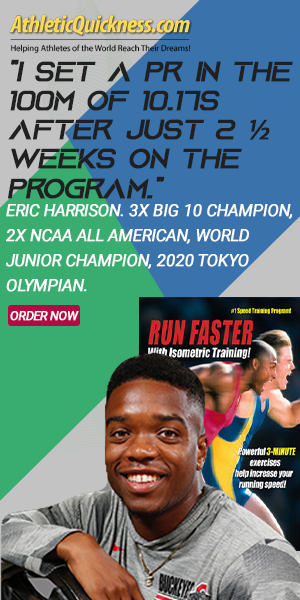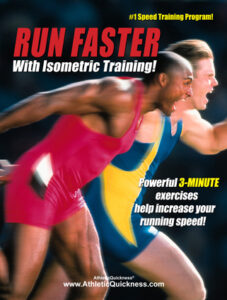Developing Bat Speed and Power in the Baseball Swing
THE BASEBALL SWING: Part 3 of 4 – The Launch Phase
Part 1 – The Stance
Part 2 – The Loading Phase
Part 3 – The Launch Phase
Part 4 – The Follow Through
When all of the muscles in the body have been properly loaded and stretched, the body is now in the position to unwind or uncoil and release this stored elastic energy to powerfully swing the bat.
This is what is known as the launching phase of the baseball swing, and it continues to the point of contact with the ball. There are five noticeable movements that take place during this phase:
1) Continuation of the timing step
2) Opening of the hips
3) Forward rotation of the spine,
4) Pushing and pulling action of the arms and shoulders
5) Guiding action of the hands on the bat
1) Continuation of the Timing Step
The timing step began in the loading phase when the front leg was raised off the ground and weight was momentarily rocked onto the back leg. Now, the continuation of the timing step is the first part of the launching phase.
Depending on the player’s technique, the timing step of the front foot can actually be a short stride towards the pitcher by a few inches and perhaps more or it can simply be placed back down on the ground as shown in the Loading Phase.
Whichever technique is used, the lowering and turning of the leading foot outward, to the ground, triggers the initiation of the swing.
This outward turning of the leading foot is caused by muscles acting higher up in the hip, the external hip rotators, and it forces the toes to point outward, in the direction of first base, as seen in Figure 1-10b.
Compare this foot position with that in Figure 1-10a, and you can see this repositioning more clearly.

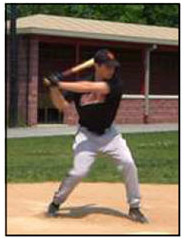
Figure 1-10a. Figure 1-10b
Because most of one’s batting power comes from hip rotation, the repositioning of the front foot is necessary since this starts the opening of both hips toward the pitcher, the direction the batter will end up facing at contact.
The contraction of the lead hip’s external hip rotators to point the toes outward (heel inward) will load or stretch the antagonistic (opposing) muscles in this same lead hip, namely the internal hip rotators. These muscles will then help further pull the batter around in the swing when he is closer to contact.
2) Opening of the Hips
Opening of the hips refers to the direction and movement when both hips turn, and eventually end up facing, when making contact with the ball, toward the pitcher. See Figure 1-11d.
This motion begins in conjunction with continuation of the timing step just described. As the lead foot is being placed back to the ground with an outward rotation caused by the opening of the same lead hip toward the pitcher, the back hip is also starting to turn toward the pitcher. To see this, compare the back (right) hip and thigh position in Figure 1-10b with that of Figure 1-10a in the Loading Phase.
This turning or opening of the back hip toward the pitcher is caused by powerful contractions in the external hip rotators of this same back hip that were previously stretched during the loading phase.
The uncoiling of these external hip rotators is the start of an incredible power release in the body as it forcibly rotates the player’s right side toward the pitcher. See Figures 1-11a through 1-11c.
This rotational hip power builds right from the onset and is further increased by the momentum and drive created by pushing of this same back leg toward the pitcher during the timing step or stride when the player’s weight is being shifted forward.
As the rotation of the back hip continues to turn and the same rear leg is driving the right side of the body toward the pitcher, the front hip is also opening toward the pitcher right along with it. See Figures 1-11a through 1-11c.
This clears an opening for the back leg to continue its drive of the back hip further toward the pitcher until the rear leg’s forward progress is met by the increasing stiffness of the front leg.
With both hips now nearly facing the pitcher, the stiff front leg forces the lead hip backward, away from the pitcher. See Figure 1-11d. This not only opens the hips further toward the pitcher but also creates a short, compact and explosive pivoting action across the player’s pelvis that carries up the spine.
The combination of the hips exploding open toward the pitcher along with the massive torque created across the pelvis by the pushing of both legs in opposite directions through ball contact, is the primary contributor of power to the player’s swing.

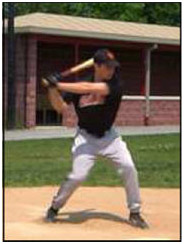
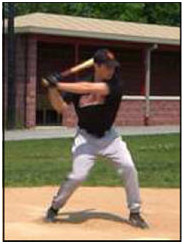
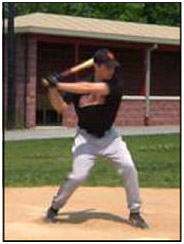
Figure 1-11a. Figure 1-11b. Figure 1-11c. Figure 1-11d
3) Forward Rotation of the Spine
As the hips begin their explosive rotation toward the pitcher and torque is building across the pelvis, this ever-increasing rotational power source is also being combined with muscles that are uncoiling along the spine.
During the loading phase, when the spine (chest, abdomen and upper body) was turned back toward the catcher, the lateral rotators of the spine on the forward or left side of the body needed to contract to accomplish this. In turn, the lateral spine rotators on the rear or right side were stretched or loaded.
Now these same stretched lateral spine rotators on the right side of the body contract tightly during the launching phase, turning the spine, including the chest, abdomen and upper body, toward the pitcher. As a result, the shoulders and arms are turned in the same direction.
We can see this turning of the spine, and consequently the shoulders and arms, back toward the pitcher in Figures 1-11a through 1-11d above as well as in Figures 1-12a through 1-12d below. Notice how the player’s numbers were not visible in Figure 1-12a but are now clearly seen in Figure 1-12d, signifying this spine and upper body rotation.
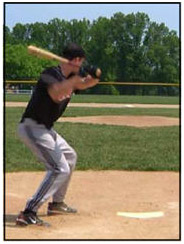
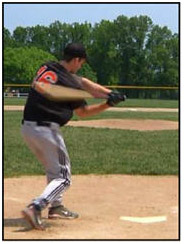
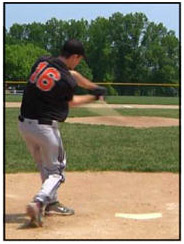

Figure 1-11a. Figure 1-11b. Figure 1-11c. Figure 1-11d
4) Pushing and Pulling Action of the Arms and Shoulders
As the hips and spine are aggressively rotating toward the pitcher, the arms are riding right along with them. In the process, they add their own force to the bat; however, each of them does so in a different manner.
First, with the rear arm, the elbow drops immediately, tucking in tight against the body and makes the shape of the letter ‘L’. See 1-13b below.
The dropping of the arm to the side is driven by the latissimus dorsi and teres major muscles that were stretched during the loading phase. The elbow also supinates in the process that forces the palm of the hand to start turning upward. This is caused by the elbow supinator muscles (page 17). As a result of these two actions, the knob end of the bat points forward. See Figure 1-13b below.
As the body continues its rotation toward the pitcher, the rear arm applies a hard, but short, push forward which brings the bat-head around near the contact point as shown in Figure 1-13c. This is caused by the pectoralis major, anterior deltoid, coracobrachialis and serratus anterior muscles.
The elbow also starts to extend in the process, though not completely. See Figure 1¬11d on the previous page. This is caused by the elbow extensor muscles (Figure 1-17, page 16).
The position of the front arm remains relatively straight with a slight bend in the elbow and a downward lean, in line with the plane of the bat. The amount of flexion in the elbow can change based on pitch location.
As the upper body rotates toward the pitcher, the muscles on the back side of the lead shoulder contract, pulling the lead arm forward toward the path of the ball. See Figures 1-13a and 1-13b. These muscles are the posterior deltoid, rhomboids, and middle fibers of the trapezius.
All of these were stretched in the loading phase and are now contracting here in the launching phase. As the lead arm nears full extension, rather than letting the force of the rotation pull the lead hand off and away from the ball, it stays on this circular path, becoming a pivot point at the bat-handle.
The latissimus dorsi and teres major muscles assist this action. This causes the bat-head to rapidly accelerate in an arc to explosive contact with the ball. See Figure 1-13d below as well as Figure 1-11d on the previous page.
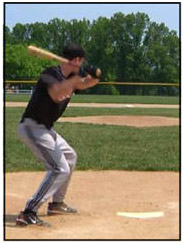
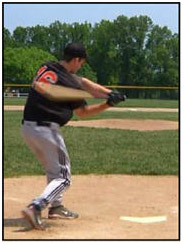

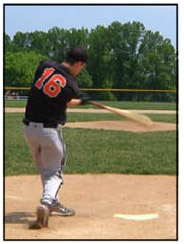
Figure 1-11a. Figure 1-11b. Figure 1-11c. Figure 1-11d
5) Guiding Action of the Hands On the Bat
The bat-head is the recipient of all the centrifugal force created in the body by the rotation of the hips and spine along with the pushing and pulling action of the shoulders and arms.
This is all made possible by seven muscles in each hand and three muscles in each forearm holding the bat-handle with a firm grip.
The hands’ and forearms’ main job is to supply direction to the bat from the initiation of the swing to contact with the ball. The hands first direct the knob end of the bat inside the flight of the pitch towards the center of the ball as seen in Figure 1-13b, page 13.
With all of the explosive movement taking place in the body, the bat-head is soon found lagging behind the hands as seen in Figure 1-11c on page 12.
The rotation of the body and the action of the shoulders and arms will help pull the bat-head around toward the contact point, however, any cocking of the wrists done during the loading process will have to be restored to their neutral position at contact.
This is because the best position for the wrists and hands to be in to transfer all of this explosive rotational power into the bat is square, or neutral, with respect to the forearms.
This means the wrists are in a position without any flexion, extension, radial deviation (abduction) or ulnar deviation (adduction) and/or any combination thereof.
Hand and wrist muscles are at their strongest in this position, which is necessary to power the bat-head through the ball without being deflected.
The ideal contact point is where the bat-head meets the ball at 90º from the direction of the pitch, give or take 15º degrees in either direction. See Figure 1-11d.
Always glad to help!
Dr. Larry Van Such
Part 1 – The Stance
Part 2 – The Loading Phase
Part 3 – The Launch Phase
Part 4 – The Follow Through

